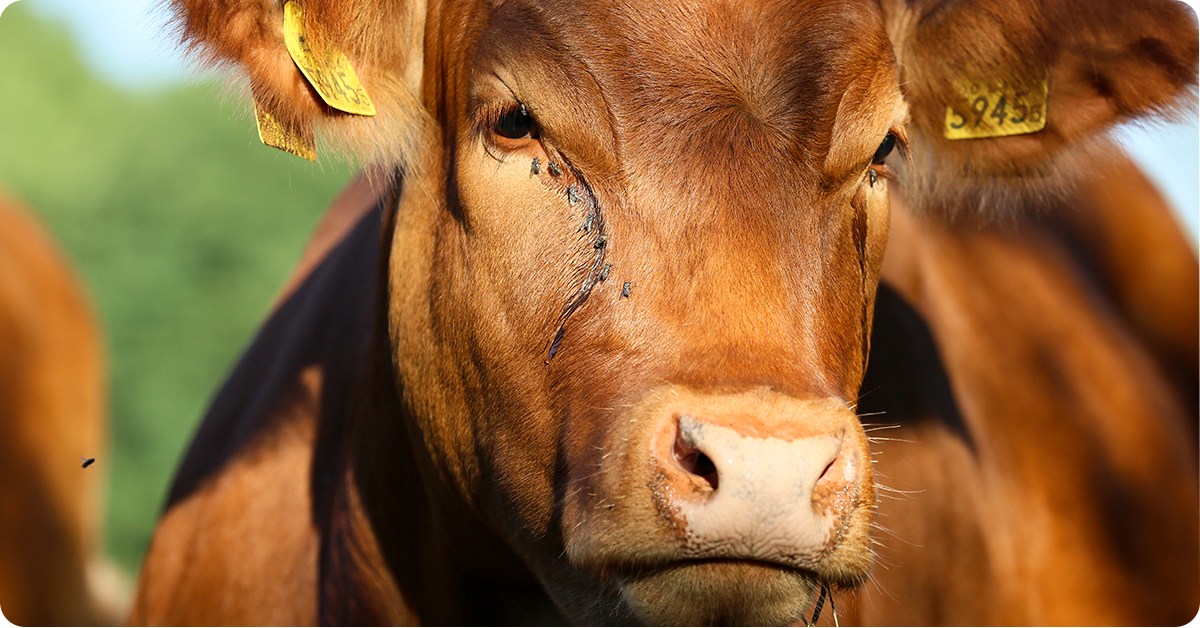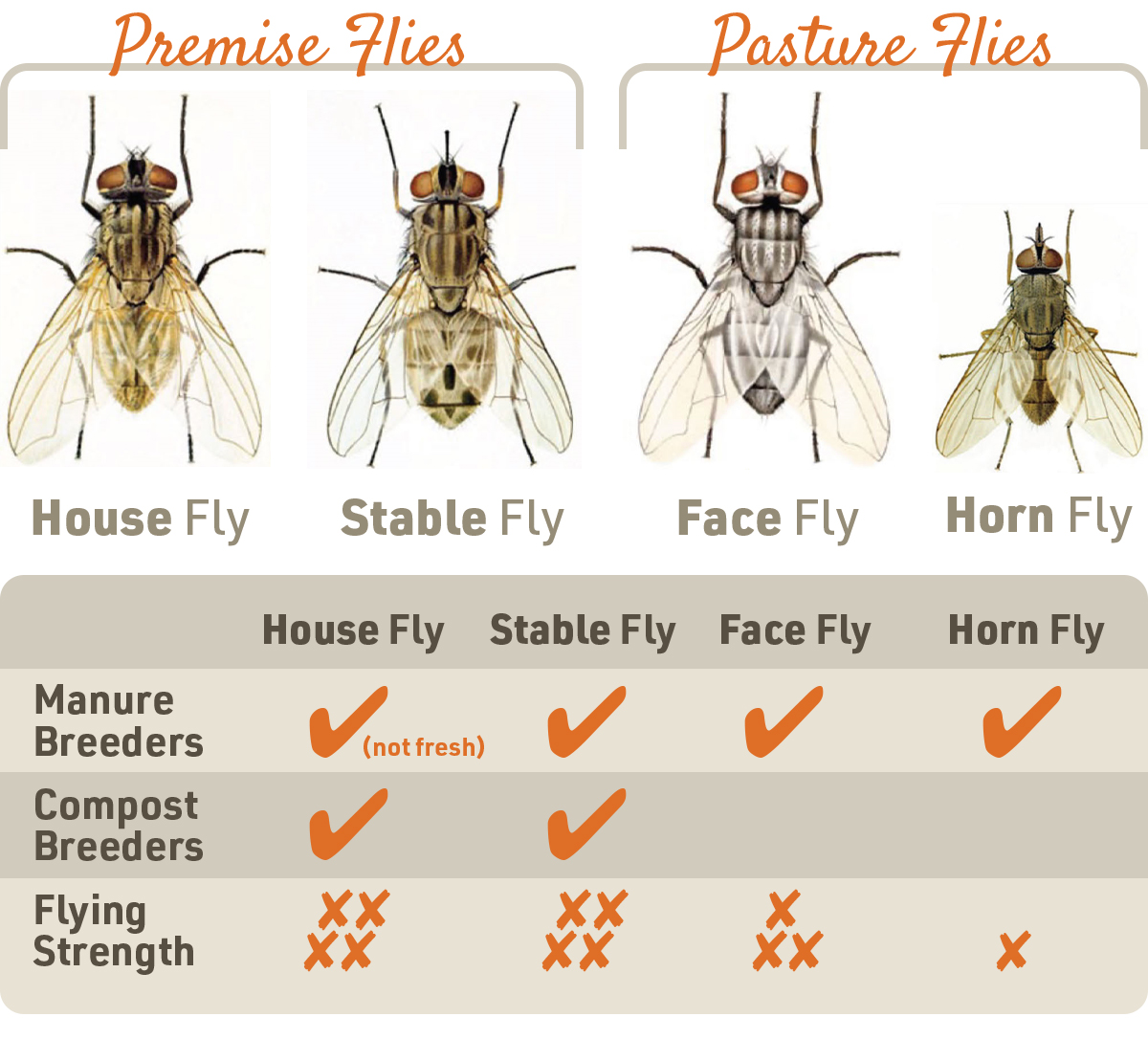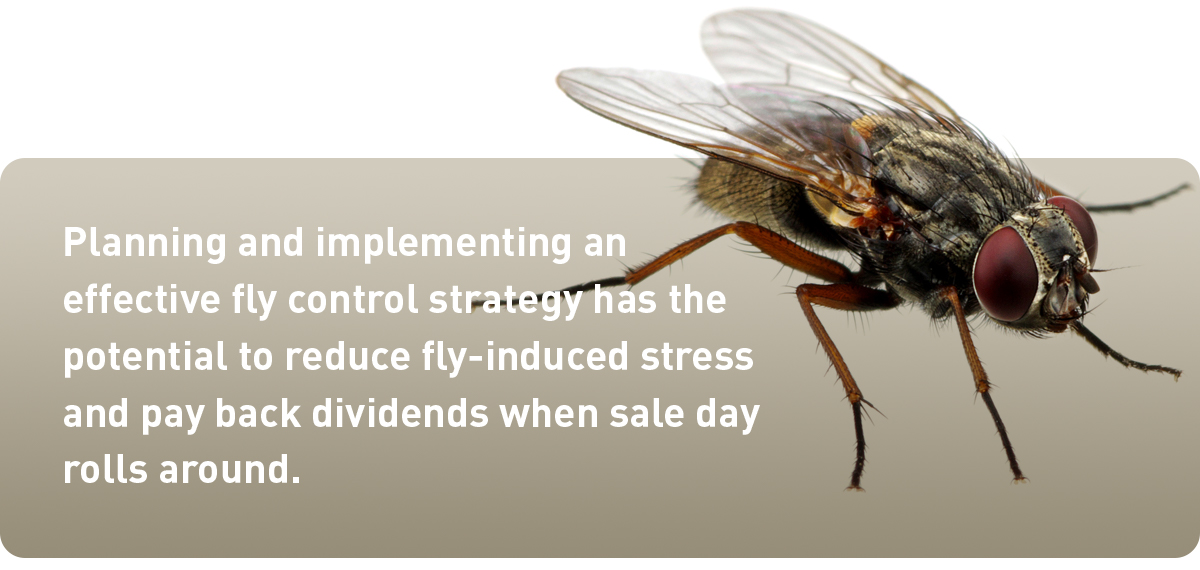
Sunshine and green pastures are great for growing cattle. The warm temperatures and abundant feed more readily available in the summer months make for a happy and healthy herd, but these prime conditions are good for more than just bovine.
Stable, face and horn flies are not-so-welcome guests that also flourish in the warmth of the summer months. Besides monotonous buzzing, these flies are known to cause harm and increase stress on cattle. Resulting in added energy drain and lower feed intake which ultimately leads to a decrease in average daily weight gains and can even cause a number of serious health problems.
With a fresh batch of calves on the ground and yet another fly season in sight, now is the time to prepare. All it takes is understanding the types of flies affecting your animals and developing a management strategy that is right for your herd and situation.

Horn Flies and Other Common Cattle Flies
From black humming clouds to thickly piled swarms on the back of an animal, flies are an undeniable nuisance whose presence can be felt all the way to the sale barn. Combating potential losses caused by flies begins simply by recognizing the varieties afflicting your cattle and understanding their habits.
Horn Flies
This cattle fly is small, but mighty. Although not the largest variety of fly impacting your herd, the horn fly’s presence is sure to be felt. The insects are most commonly found on the backs, sides and necks of cattle and spend most of their time on the host in sizable concentrations.
Horn flies are biting insects whose primary diet is blood. These bites irritate cattle, and since a single horn fly can feed as many as 30 times in a single day, it is not surprising that affected animals often see drops in ADG. A concentration of just 200 horn flies has the potential to decrease a cattle’s weight by anywhere from 15-50 pounds.
Stable Flies
Stable flies are medium in size when compared to horn and face flies and are similar in appearance to house flies. They are usually found on the legs of host cattle. Like the horn fly, stable flies are blood feeders who bite to access their meal but primarily occupy the host only while feeding.
Stomping, tail swishing, bunching together in groups and laying down with legs tucked are all behaviors typical of cattle being terrorized by stable flies. These behaviors increase metabolic activity and decrease feed intake which greatly impacts ADG and even causes weight loss in some cattle.
Face Flies
Face flies are the largest fly variety that commonly plagues cattle. Unlike biting horn or stable flies, face flies are a non-biting insect that feeds on secretions from the eyes, mouth and open wounds. The flies will often cluster around these areas and cause a great deal of annoyance to animals as these flies use their rasp-like mouths to irritate and promote secretions.
Besides adding to stress levels and increasing the energy burned through attempts to dislodge the pests, face flies are potential spreaders for diseases. Moraxella Bovis (M. Bovis), the primary cause of pinkeye in cattle, and Infectious Bovine Rhinotracheitis, a disease of the respiratory system, are both easily contracted and spread by face flies.

Strategies and Methods for Controlling Flies
When formulating your fly management strategies, it is important to consider your herd’s particular situation. Pasture size, location and even moisture levels can all play a role in the effectiveness of certain fly control methods and products.
Common methods of fly control include pour-ons/sprays, ear tags, feed throughs and dust bags/back rubbers. Depending on your situation it could be beneficial to incorporate multiple methods to your strategy.
Pour-Ons/Spray Insecticides
Pour-ons and sprays are effective fly control tools for a limited amount of time. Sprays are typically applied to the entire animal whereas a pour-on is applied along the animal’s back. These products can greatly reduce the impact of flies on animals grazing a variety of pasture types.
These products require re-application throughout the fly season. Sprays must be applied quite regularly so it is important to have easy access to cattle when using this method. Pour-on insecticide products generally last several weeks but still require re-application several times throughout the season.
Fly-Control Ear Tags
Insecticidal ear tags are one of the most widely used fly control methods available. These ear tags come in a number of different brands and varieties of chemical combinations. Each type of tag will affect fly groups differently and to various extents, but overall they provide an effective form of relief for cattle on any kind of summer range.
This method is perhaps the most effective for ranchers whose cattle spend the summers far from any working facilities and are widely spread out. Fly tags are easily applied during the spring vaccinating and branding season and typically stay with the animal throughout the summer months.
Ear tags do lose their effectiveness as the season progresses, or when exposed to rain and other elements. It is recommended to remove fly tags in the fall and rotate brands each year to limit insect resistance to them.

Feed Throughs
Feed through methods not only repel flies but also help limit the overall population. These products are ingested by cattle via tubs, blocks or feed supplements and work to interrupt the life cycle of maturing flies.
This fly-control technique is most effective if the feed-through product is easily accessible and in a highly trafficked area, such as near water sources. It is also more effective in situations where tubs, blocks, or supplements are easily replaced so access is consistent.
The biggest drawback to feed-through products is cost. It is a more expensive form of fly control and cattle must ingest adequate levels of the product in order to be most effective, but returns on increased cattle weights easily offset costs if this strategy is implemented correctly.
Dust Bags/Back Rubbers
Dust bags and back rubbers are effective tools in the fight against flies when placed in areas they are sure to be used by cattle. Dust bags and back rubbers are both treated with pesticide chemicals that are spread to the cattle when the animals come in contact with the applicators.
This method of fly control is best for pasture situations that can guarantee contact with the applicators such as in areas where water access is limited or regulated. If your pasture is separated from the primary water source by a fence, the gate would be a perfect location for an applicator as cattle are likely to come into contact with it on a daily basis as they access the water.
Dustbags and back rubbers become less effective in large pasture situations or where contact cannot be so readily ensured. Usefulness also decreases in wet environments as this can cause the pesticides to dilute and become ineffective.

Beat the “Buzz”
Incorporating complementary methods to your fly-control and management strategy has the potential to reduce fly-induced stress and increase your sale-weights once fall rolls around. When designing your management strategy, keep in mind facility maintenance & cleanliness and adhering to product guidelines can make a big difference in maximizing each method’s ROI.
With an extensive collection of cattle fly control products, your local IFA Country Store can help you find the right mix of fly-control methods & products for your herd’s unique situation.
Planning and implementing an effective fly control strategy has the potential to pay back dividends when sale day rolls around, and now is the time to get started. Consider evaluating your current management strategies and let us help you explore all the fly-control options, or maybe even discover something new for the coming warm season.
Written by Mikyla Bagley, IFA Content Specialist, and originally published in the IFA Cooperator magazine (vol. 87, no. 2) Summer 2021.
Mikyla Bagley is a fifth-generation rancher actively involved in her family’s cattle operation. She holds a deep respect for the wisdom and management practices of the farmers and ranchers who have crossed her path, both because of her family operation and otherwise. A deep desire to remain connected to the agriculture industry drove Mikyla to earn her BIS in Agriculture Science and Communication from Southern Utah University this past spring. She continues to be involved in her family’s operation while using her degree and life-long experience in her new role to share the experience and wisdom of IFA experts and Co-op Members as IFA’s Content Specialist.
“The agriculture community is filled with genuine and hard-working men and women whose passion for their lifestyle deserves to be shared. I look forward to helping highlight both their stories and expertise in the coming future.”
—Mikyla Bagley
Information provided by Doug Skyer, D.V.M. Nutritionist & Animal Health Consultant at IFA South Region Feed; and Martha Page, Animal Health Category Manager, IFA Feed & Nutrition. Fly Control Product Comparison Chart. PBS Animal Health. Edward Pruss. 2021. “Flies Can Impact Summertime Beef Cattle Production.” Penn State Extension.








